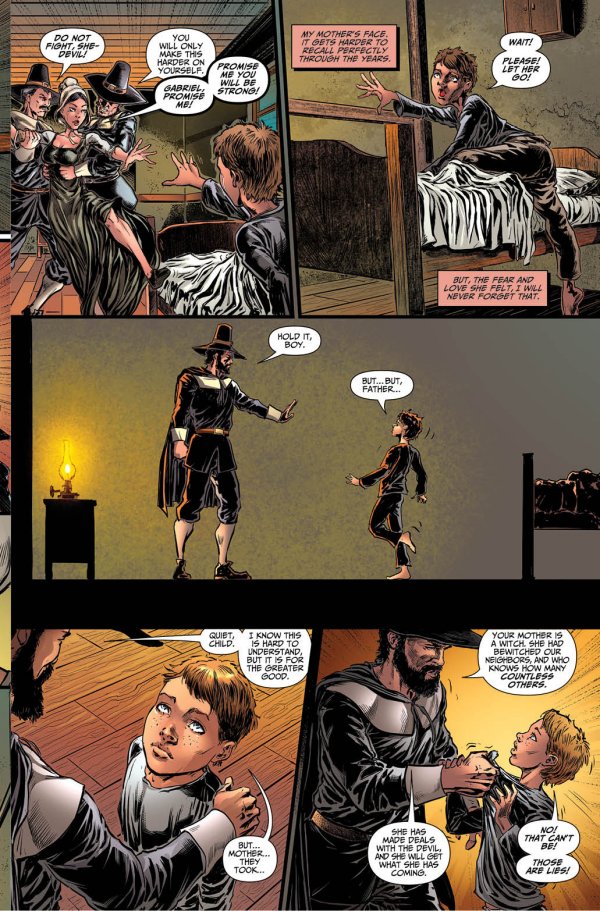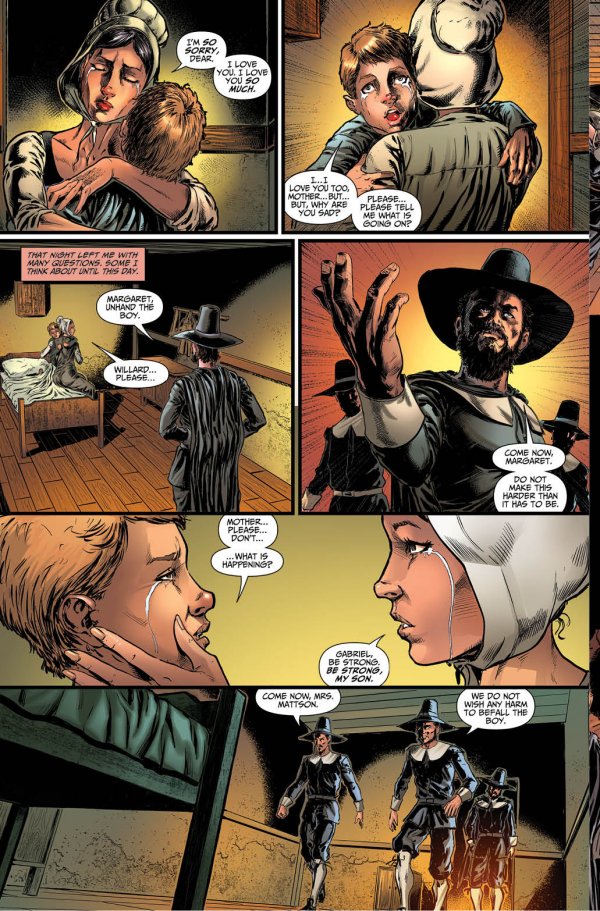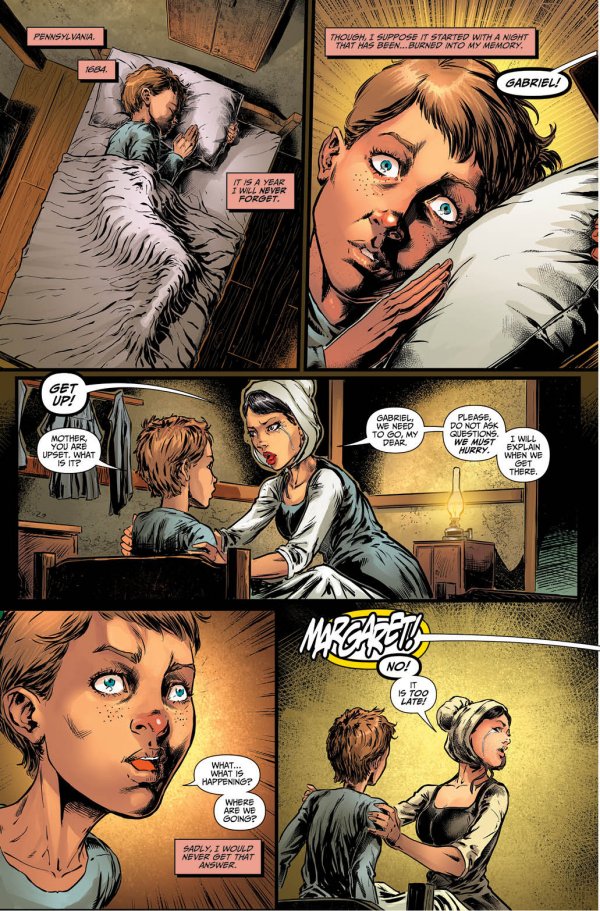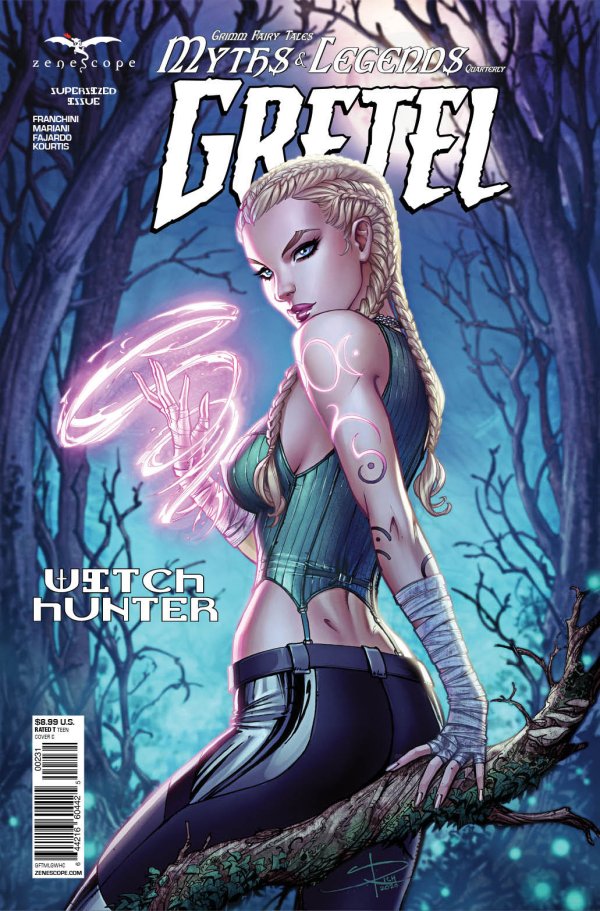 Hatred may be consuming … but it can also be eternal.
Hatred may be consuming … but it can also be eternal.
Creative Staff:
Writer: Dave Franchini
Artwork: Alessio Mariani, Guillermo Fajardo, Babisu Kourtis & Dario Tallarico
Colors: Juan Manuel Rodriguez, Ulises Arreola, Leonardo Paciarotti & Maxflan Araujo
Letters: Taylor Esposito
Lettering Assistant: Mariano Benitez Chapo
What They Say:
Gretel’s life has been coupled with one trauma after the next, starting with the loss of her brother at a young age and then her mentor just recently, both due to the machinations of an evil witch. Cursed with powers that grant her a long life that spans centuries, she is forced to consume human hearts to sustain herself at the cost of her humanity. Recently, she has teamed up with Calabar, a mercenary who is part of a secret faction determined to rid the world of all witches. But now, what they have discovered could unravel everything they have been working so hard to create. A new coven of witches is forming, and at its center, a new evil rises, something so powerful that they may not be enough to protect us.
Content (please note that portions of review may contain spoilers):
In Pennsylvania during the year 1684, a young boy was awakened by the desperate cries of his mother Margaret, who is frantic to take her son Gabriel away from some apparent danger, but when he tries to ask what was wrong, his father Willard stops their escape attempt and has the panicked woman escorted away amid foul insults. But when the confused youth tries to go after her, his stern parent stops the child and accuses his wife of being a witch, to which his son fervently denies this treachery and bites his hand in order to be released from a firm hand restraining him. It is only after running from his home is he stopped by Father Enoch, who boldly confirms the claim and gently directs his gaze toward the town square, only to gaze upon his mother and two other women who were bound to stakes buried in piles of kindling. Even as the anguished child cries to the comforting priest to stop this charade of a trial, the pious clergy dons the face of a fanatic and pronounces his foul sentence upon the guilty. However as the hungry flames lick tender flesh and an affectionate mother painfully screams for her son not to listen to their lies, all watch in stunned amazement as mystical energies flee from their bodies and find a new host within the devastated boy. While the assembled were confused what to do next, it was the overly zealous priest who orders Willard to secure his son as another produces a searing mask from the bonfire, with this being the last night that Gabriel would ever see with unclouded eyes.
As Gretel peacefully waits by a serene mountain pool, she recalls recent events of a warlock in Pennsylvania who has been creating covens of witches and expanding outwards, composed of inexperienced women who are hungry for power. Although they may not know where he came from or why now is the moment to focus his ambitions, all of the information they have been able to gather has lead to these woods, and as far as this hunter is concerned he is a warlock and it is her job to stop him from harming anyone else. However sometimes her prey decides to strike first and this opportunity is no exception, with a hulking tree spirit emerging from the ground before the unfazed woman who was not surprised by this attack, instead taunting her assailant before it makes its intentions clear. As the lumbering creature raises a massive wooden fist in preparation to attack, a sudden impact separates its limb at the shoulder, immediately followed by another thunderous strike which shatters its stunned face and immediately ends the fight. And yet as a self-assured Gretel speaks into an earpiece and thanks the unseen person for their unneeded help, an equally smug Calabar replies from her snipers’ nest that she couldn’t let her friend have all the fun, with the cocky blonde thanking her companion for looking out for her. While their biting banter continues, it was rudely cut off as her fellow witch hunter’s conversation is cut short, to which the alarmed girl tries to get a response, but as the panic intensifies, those worries were soon put to rest as an equally gigantic maul pummels her into silence.
In Summary:
Ever since we saw that grimly sinister face at the end of Belle: Hearts & Minds One-Shot and were haunted by the man’s ominous words, it was only a matter of time until that nightmare came back with a vengeance, and writer Dave Franchini does not disappoint with this grand unveiling of his history and how it ultimately involves our favorite witch hunter. But of course, what makes this repugnant story all the more haunting is how this talented author has woven a twisted thread of truth introducing the tale, beginning with the suffering of Margaret Mattson which is based on an actual witch trial in Pennsylvania, even if she was originally found not guilty in that nonsensical farce, making this painful reimagining all the more gripping and horrific. But what adds to the sickening distortion of this morbid interpretation is the leading antagonist who shapes a young Gabriel into what he is today, the fanatical priest whose perverse fascination with the objects of his persecution is the foundation of both of their hatred – Father Enoch; while we may try to ignore any biblical connotations his name may have, one cannot overlook the deplorable personality which drives his amoral machinations and the demented views that will shape a poor boy who has fallen under his religious sway. But at the years progress and the young child has no other choice than to obey this charismatic priest, it is baffling to comprehend how people could submit to these detestable pious travesties, all thanks to spurious evidence which one man fabricates and allows his followers to carry out cruel sentences, so that he may get his hands dirty as little as possible.
And yet as these holy punishments become more severe due to Enoch’s desperation to learn the dark secrets of his victims, it is only then does his sanctimonious notion of seeing witches destroyed manifest into a hypocritical perversion rooted within the unfortunate boy which he ritualistically branded so long ago. To watch as a beguiling salvation signals the beginning of the end, it is sickening to think these people would follow the same rites which Tituba utilized to create her own mystical offspring, especially given how they supposedly detest these demon spawn, only to become one themselves to show the holy devotion ingrained into their passion to stop this foul corruption from spreading. Strangely these single minded followers do not hesitate, fully trusting Father Enoch into thinking he knows what is best for their righteous cause, even as he once again does not partake in this forbidden ritual, only standing back and witnessing in perverse pleasure as they carry out his foul orders.
But even when Gabriel and Isabel are finally free from this holy crusade, while you wish to feel sympathy for this couple’s plight of being persecuted for over a decade, you cannot but become disgusted by the teachings which have been implanted within this now young man’s psyche, perhaps from loneliness of wanting more of their kind or some corrupted moral ideal of witches being a more fitting race, you cannot but sense his emptiness even as those abhorrent principles become his own. Gone now is the remorseful child who so sincerely wished to save this mother, now befouled into wicked corruption which she would never recognize and perhaps immediately reject due to innocence lost, turning away from what she tried to save and in the end becoming that which took her life unjustly, a self-righteous reflection of the one person who is at the source of all their suffering and more – Father Enoch.
While this insidious narrative may be chilling from the opening moments and only become all the more pervasive and nauseating as it progresses, it could not have such an unsettling and traumatic effect if not for the equally touching and horridly despicable visual resonance which this special displays from the devastating opening as portrayed by the wildly expressive illustrations of Alessio Mariani, with a stunning color scheme from Juan Manuel Rodriguez which focuses the readers’ attention due to a pronounced usage of wisely placed shading, nuanced concentration of limited light sources, and striking backgrounds of muted tones plus motion lines which cause our eyes to be attracted to a central image within each panel, making the entire introductory sequence a wonder to explore and a horror to accept as it unfolds without hesitation. Mariani creates a monumental moment from the beginning, all thanks to the captivating attention to detail which he takes in displaying the innocence of Gabriel, blissfully dreaming until he is roused awake by his mother’s scream, the immediate shock is so deeply etched into his face that the reader cannot but know something is coming, and it is made all the more worrisome thanks to Rodriguez’s clever usage of a bright halo of light and action lines to isolate his concern as the moment is compounded with each provocative image which follows.
The audience cannot but become emotionally invested within this fierce fight for survival through the eyes of a confused child, watching as his world is ripped asunder as all who are supposed to protect him are either viciously torn away or morbidly cooperate within this sinister act of insanity. How could one who has any sense of justice not want to leap head first into this event to stop such archaic barbarism, only amplifying our own lack of ineffectualness by thinking any effort can deviate a work of fiction, in turn answering how powerful this visual presentation can provoke the audience’s unsettled ire. To watch his so-called father depicted with such a foreboding presence thanks to the judgmental view and made all the more maddening due to the dark shading from his grandiose gesture and the somber background colors, pronounced dark shadows and more action lines, it is this image which secures the grimness of what is to come. Even as he struggles, one cannot surrender to the hope which this boy expresses within his questioning reactions, which is forcefully dispelled after he is forced out of the house and asks for help from the one thought could help, the religious leader of the village and enlightener of the truth – Father Enoch.
And yet all of that understanding vanishes once we see this strict disciplinarian enshrouded within the same darkness which his own parent was bathed within, wrinkles etched into his face showing the same madness which seems to spread to all who follow him. It is from this turn of events that we know Gabriel’s life will never be the same as he is turned to see his mother and two others bound to separate pyres, their fate now sealed as all descend into the madness of disgusting pious travesties. And yet as we are taken to the present day with Guillermo Fajardo’s almost gentle depictions of Gretel, made all the more serene due to Ulises Arreola’s calming palette, the terrifying mood which was displayed before seems almost dismissed thanks to the calmness of a mountain pool. However, this peaceful setting is soon shaken thanks to the sharp line definition of the figures and almost too bright skin tones of our defiant heroine as she faces the wooden foe, quickly becoming a sobering event as the darkness of her enemy begins to materialize within the smothering surroundings.
However, this distress turns comical and seemingly out of place as Calabar reveals herself, allowing the two to amusingly banter until the story becomes more deadly as their rivals gain the upper hand. It is within this epic battle where Fajardo’s impressive illustrations become more organic as we met Isabel within her arboreal lair, allowing for Arreola to combine pastel tones with colors which seem out of place within a canopied area, this combination permits the impending excitement to flourish with the energetic mysticism which our witch hunter is known for and expresses within this rousing battle. And yet this enthusiastic action does not last long as Babisu Kourtis expresses a more serious moment within the story as we finally enter the witch’s lair, with his fantastically defined linework which portrays the seriousness of the moment upon the faces of our actresses, but as the same time Leonardo Paciarotti palette seems a bit inappropriate with colors which are at times too illuminated for an underground passageway, with almost glowing skin tones and clothing textures too well defined for an area which is barely lit. The crispness of Kourtis’ images are overemphasized at times, but at the same time it makes the frenetic nature of Gretel and Calabar’s struggle all the more dynamic, propelling the reader into the uncertainty which is to follow. But it is the haunting flashback of our heroine’s past as portrayed by the rustic charm of Dario Tallarico’s images which gives readers a haunting pause due to the immediate recognition of a familiar fairy tale, made all the more disarming once we see an endearing woman offering the hungry children some delicious sweets, even as those who know this is Tituba feel a chill race down their spines.
This innocent scene is made all the more heart warming thanks to Maxflan Araujo’s wonderfully limited choice of colors to help to emphasize the rural nature of the area, using only muted earthly tones with touches of golden light to reflect the tranquility of a helpful woman within her secluded home, made all the more pleasing to see her offering colorful treats to the drawn and haggard faces of the starving Hansel and Gretel. But even as you cannot but smile to see the delight of their hunger being satisfied with pleased smiles, it is then when the color scheme switches to something all the more sinister, with shadows growing longer with clawed hands, the sincere fright upon the once greedy and now sweat drenched faces of the children shows us the scary turn events have taken, allowing us to immediately understand what is happening with only a few well portrayed images of panic and absolute terror. It is then when those familiar with our witch hunter’s story now feel the gripping remorse and tears of pain reflected within the next page, allowing us to fully understand the heart crushing trauma which this cellar stirred up from so many centuries of much need and wanted denial. These shocking pictures bring us full circle to the present, permitting the audience to understand the events which have shaped our heroic antagonist and the mournful moments that twisted her foe into a callous beast who only cares for revenge against the one who he thinks have taken his family, never fully understanding he is just as guilty for turning them into witches who feed upon the innocent, forgetting he is the true monster within this cycle of hatred.
Grimm Fairy Tales Myths & Legends Quarterly: Gretel Witch Hunter is a sensational revelation of how unbridled hatred can turn even the most noble crusade into a corruption of the spirit, one in which a fervent zealot can distort the purest of notions into a perversion of accepting teachings, and in turn cause the innocent to become consumed within a man made pyre fueled by jealousy and sickening accusations corrupted to serve selfish needs. With haunting illustrations which materialize the ugliest of humanity’s misdeeds and give them form plus unsettling color palettes that anchor those unwanted emotions within these sometimes nauseating pages, this one shot allows readers to reflect on what can happen if unrestrained terror is the only path to acceptance, with no one brave enough to speak out in fear of reparation. This magnificent special is a resounding echo of what can happen when the morally bankrupt are chosen to lead, with no one left to resist their nonsensical remarks and follow with unwavering submission to the most callous of claims, leaving the easily manipulated and those who have no other choice than to accept what they know is wrong, resulting in an endless cycle of tragedy and grief from which there is no foreseeable end.
Grade: A+
Rating: T (Teen)
Released By: Zenescope
Release Date: January 27, 2021
MSRP: $8.99








